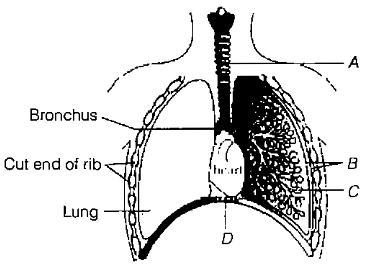What amount of carbon dioxide is delivered by every 100 ml of deoxygenated blood to the alveoli?
1. 4 ml
2. 5 ml
3. 15 ml
4. 20 ml
प्रत्येक 100 मिलीलीटर विऑक्सीजनित रूधिर द्वारा कूपिका में कार्बन डाइऑक्साइड की..............मात्रा को वितरित किया जाता है।
1. 4 ml
2. 5 ml
3. 15 ml
4. 20 ml
Reduction in pH of blood will
(1) reduce the blood supply to the brain
(2) decrease the affinity of hemoglobin with oxygen
(3) release bicarbonate ions by the liver
(4) reduce the rate of heart beat
रक्त की पीएच में कमी से होगा:
(1) मस्तिष्क को रक्त की आपूर्ति में कमी
(2) ऑक्सीजन के साथ हीमोग्लोबिन की बंधुता में कमी
(3) यकृत् द्वारा बाइकार्बोनेट आयनों को निर्मुक्त करना
(4) हृदय स्पंदन की दर में कमी
The figure shows a diagrammatic view of human respiratory system with labels A, B, C
and D. Select the option, which gives correct identification and main function and/or
characteristic.

1. A-trachea-long tube supported by complete cartilaginous rings for conducting
inspired air
2. 8-pleural membrane-surround ribs on both sides to provide cushion against rubbing
3. C-alveoli-thin walled vascular bag-like structures for exchange of gases
4. D-lower end of lungs-diaphragm pulls it down during inspiration
A, B, C और D नामांकन के साथ आकृति मानव श्वसन प्रणाली के आरेखीय दृश्य को दर्शाती है, उस विकल्प का चयन करें जो सही पहचान और मुख्य कार्य और/या विशेषता देता हो:

* Bronchus - श्वासनली
* Cut end of rib - पसली का कटा हुआ सिरा
* Lung - qफेफड़ा
1. A- श्वासनली - वायु चालन के लिए पूर्ण उपास्थि वलयों से जुड़ीं लंबी नलिका
2. B- फुप्फुस झिल्ली - पसलियों को रगड़ से बचने के लिए उनके दोनों तरफ गद्दीनुमा संरचना बनाना
3. C- कूपिका - गैसों के विनिमय के लिए पतली भित्तिनुमा संवहनी थैली जैसी संरचना
4. D- फेफड़ों के निचले भाग - प्रश्वसन के समय डायाफ्राम इसको नीचे खींचता है।
What is vital capacity of our lungs?
1. Inspiratory reserve volume plus tidal volume
2. Total lung capacity minus expiratory reserve volume
3. Inspiratory reserve volume plus expiratory reserve volume
4. Total lung capacity minus residual volume
हमारे फेफड़ों की जैव क्षमता कितनी होती है?
1. प्रश्वसन आरक्षित आयतन और श्वसनवायु आयतन का योग
2. पूर्ण फुप्फुस क्षमता और निःश्वसन आरक्षित आयतन का घटाव
3.प्रश्वसन आरक्षित आयतन और निःश्वसन आरक्षित आयतन का योग
4.पूर्ण फुप्फुस धारिता और अवशिष्ट आयतन का घटाव
Which one of the following is the correct statement for respiration in humans?
1. Cigarette smoking may not lead to inflammation of bronchi
2. Neural signals from pneumotoxic centre in pons region of brain can increase the
duration of inspiration
3. Workers in grinding and stone breaking industries may suffer, from lung fibrosis
4. About 90% of carbon dioxide () is carried by haemoglobin as carbamino
haemoglobin
निम्नलिखित में से कौन सा मनुष्यों में श्वसन के लिए सही कथन है?
1. सिगरेट पीने से श्वसनिका की शोथ नहीं हो सकती है।
2. मस्तिष्क के पोंस क्षेत्र में स्थित श्वास नियमन केंद्र तंत्रिका संकेत द्वारा प्रश्वसन की अवधि में वृद्धि कर सकते हैं।
3. घिसाई और पत्थर तोड़ने वाले उद्योगों में कार्यरत मजदूरों को फुप्फुसीय तंतुमयता से पीड़ित होने की सम्भावना होती है।
4. हीमोग्लोबिन द्वारा लगभग 90% कार्बन डाइऑक्साइड (CO2) को कार्बेमिनो हीमोग्लोबिन के रूप में जाया जाता है।
Name the pulmonary disease in which alveolar surface area involved in gas exchange is
drastically reduced due to damage in the alveolar walls.
1. Pleurisy
2. Pneumonia
3. Emphysema
4. Asthma
उस फुफ्फुसीय रोग का नाम बताएं जिसमें कूपिका भित्तियों के क्षतिग्रत होने के कारण गैस विनिमय में सम्मिलित कूपिकाओं का पृष्ठीय क्षेत्रफल अत्यधिक कम हो जाता है।
1. फुप्फुसावरण शोथ
2. न्यूमोनिया
3. वातस्फीति
4. दमा
Which of the following factors are favourable for the shifting of Oxyhaemoglobin dissociation Curve to the left side
1. High Temperature
2. high pH
3. Low pH
4. None of these
निम्न में से कौन से कारक ऑक्सीहीमोग्लोबिन वियोजन वक्र के बाईं ओर विस्थापन के लिए अनुकूल हैं?
1. उच्च तापमान
2. उच्च पीएच
3. निम्न पीएच
4. इनमें से कोई नहीं
The binding of Hb with oxygen forms
1. Methamoglobin
2. Carbhaminohaemoglobin
3. Oxyhaemoglobin
4. Carbaminohaemoglobin
Hb के साथ ऑक्सीजन के बंधन से निर्मित होता है:
1. मथ्नोग्लोबिन
2. कार्बोहिमोग्लोबिन
3. ऑक्सीहीमोग्लोबीन
4. कारमैनो हीमोग्लोबिन
What is true about RBCs in humans?
1. They carry about 20-25 per cent of CO2
2. They transport 99.5 per cent of O2
3. They transport about 80 per cent oxygen only and the rest 20 per cent of it is
transported in dissolved state in blood plasma
4. They do not carry CO2 at all
मनुष्यों में आरबीसी के विषय में क्या सही है?
1. वे लगभग 20-25 प्रतिशत CO2 ले जाते हैं।
2. वे लगभग 99.5 प्रतिशत O2 का परिवहन करते हैं।
3. वे लगभग केवल 80 प्रतिशत ऑक्सीजन का परिवहन करते हैं और शेष 20 प्रतिशत का परिवहन रक्त प्लाज्मा में घुलित अवस्था में होता है।
4. वे CO2 नहीं ले जाते हैं।
The partial pressure of oxygen in the alveoli of the lungs is
(1) equal to that in the blood
(2) more than that in the blood
(3) less than that in the blood
(4) less than that of carbon dioxide
फेफड़ों की कूपिकाओं में ऑक्सीजन का आंशिक दाब होता है:
(1) रक्त की तुलना में उसके बराबर
(2) रक्त की तुलना में अधिक
(3) रक्त की तुलना में कम
(4) कार्बन डाइऑक्साइड की तुलना में कम


